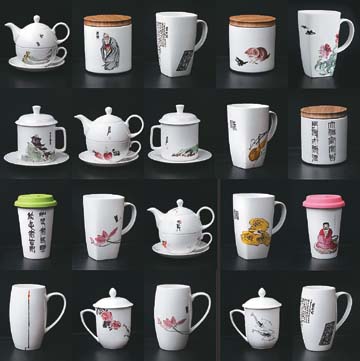|
Debra Li

THE first porcelain utensils, cotton bags, wooden and crystal handicrafts, as well as notebooks featuring Qi Baishi’s paintings and calligraphy are on display at Artron Art Gallery until the end of the Chinese year.
On May 22, one of Qi’s paintings, “Eagle Standing on a Pine Tree,” was auctioned for 425.5 million yuan (US$67 million), making it the most expensive Chinese work of art by an artist in the recent history. Born in 1864 in Xiangtan, Hunan Province, he was most noted and admired for his whimsical, often playful water color paintings.
For the past three years, Artron has acquired a license to display nearly 300 pieces of Qi’s works. Apart from high-fidelity copies of his paintings, the company produced teapots, cups, sealed porcelain cans, iPad bags, notebooks, cards and other handicrafts adorned with Qi’s paintings and calligraphy so that afficionados can enjoy his art in daily life.
On display in a first-floor hall at the gallery are more than 40 examples of porcelain, a dozen wood handicrafts and some 40 copies of Qi’s paintings among other things. These are arranged in four categories according to Qi’s various styles in different periods.
“Qi’s art matured after he entered his 40s,” said Li Zhiqi, a spokesman for Artron. “He called his study ‘Hui Wu Tang’ in memory of his late parents because he thought he had not enough time to fulfill his filial obligations and regretted it. Later after he had settled in Beijing for some time, he called his study ‘Ji Ping Tang’ to express his nostalgia.”
Li said most of the handicrafts feature Qi’s works during the two latter periods, which are of higher aesthetic value.
Visitors can buy the porcelain utensils, priced between about 300 yuan and several thousand yuan, as well as other works on display.
|

